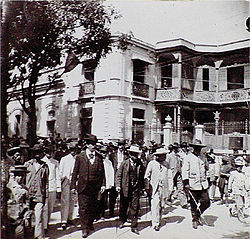Revolution in Venezuela
The Restorative Liberal Revolution, also known as the Invasion of the 60 due to the number of men with whom the movement began,[1] was an expedition of Venezuelans exiled in Colombia under the command of Cipriano Castro that began on 23 May 1899, with the purpose of overthrowing the government of Venezuelan President Ignacio Andrade.
Origin
The political crisis experienced by the regime of Ignacio Andrade, and Yellow Liberalism in general, after the death of Joaquín Crespo in the Battle of Mata Carmelera [es], was an opportunity for Cipriano Castro to launch the last phase of the revolutionary movement that he had been organizing in his exile in Colombia, since the defeat of the Legalist Revolution in 1893.
Initially, he proposed an alliance with Carlos Rangel Garbiras [es], also in exile, but given the failure of the talks and the fragility of the Andrade government, he decided to rely only on his 60 men and the Castro Restorative Liberal party that awaited him in Táchira. So he began his revolution crossing the border of the Táchira River on 23 May 1899.
Development
The forces of the rebels grew as they entered the Venezuelan Andean center to overthrow the unpopular Andrade government. On 12 September, with already 2,000 troops under his command, Castro defeated 4,000 government soldiers commanded by the Minister of War, General Diego Bautista Ferrer, in the Battle of Tocuyito [es], who lost 2,000 men trying to assault the enemy positions.[2]
Two days later Andrade assumed personal command of the government army and Castro launched a coordinated offensive against Caracas. After this, several warlords and their militias deserted to the rebel side. When Castro was preparing to confront Luciano Mendoza [es] in La Victoria, he was surprised that General Ferrer decided to disobey the government's orders and not confront him. With 10,000 soldiers, Castro entered the capital on 23 October[2][3] with generals and caudillos Luciano Mendoza, Samuel Acosta and Luis Lima Loreto by his side.[4] Andrade is overthrown in a coup and forced into exile on Curaçao.[2]
